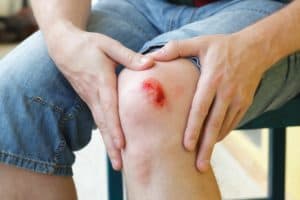
Often times when we get a skin injury, we simply put a band-aid on and go about our day. What we don’t realize, or pay attention to, is the complex series of events that our bodies are going through to make sure that our wounds heal properly. The process at which our wounds heal can be categorized into four different stages, but remember all bodies are different and all wounds heal differently!
Hemostasis Phase: This phase of healing starts immediately after the wound appears. Your body activates a blood clotting system and starts to build a dam to block the draining blood. Blood platelets come in contact with collagen forming an enzyme called thrombin. This forms a fibrin mesh, which strengthens the platelet clumps into a stable clot.
Inflammation Phase: Once the bleeding stops and the wound is closed the blood vessels can open up and send fresh nutrients and oxygen to the wound to help with the healing process. Making sure the right amount of oxygen gets to the wound is essential to healing, too much or too little and the wound will not heal properly. White blood cells, also called macrophage, are known as the wound protectors. These white blood cells fight infection and make sure the repair process is in play.
Rebuilding Phase: When the wound gets to this phase, its main goal is to fill and cover the wound. In this phase of healing, the red blood cells arrive to help build new tissue. These cells signal cells to create collagen so other tissues can build off of them. If your wound starts to scar and has a red appearance, it will eventually fade thanks to this phase.
Maturation Phase: This is the phase where the new tissue starts to gain strength and flexibility. The collagen fibers and tissue reorganize and remodel to increase the overall strength of the skin. During this phase, you may notice that your skin is stretching, puckering, or even itching, this is all part of the healing and rebuilding process. Give it about three months and the wound will be almost as strong as it was before the incident. However, the entire healing process can take several years to complete (depending on the wound).
The healing process is extremely complex, remarkable, and fascinating. Remember, that all wounds and bodies heal differently! The next time you get a wound and put a band-aid on, don’t forget what your body is doing to help heal your wound and get you back to normal!
Disclaimer: This blog provides general information and discussion about medical, cosmetic, mohs, and surgical dermatology. The words and other content provided in this blog, and in any linked materials, are not intended and should not be construed as medical advice. If the reader or any other person has a medical concern, he or she should consult with an appropriately-licensed dermatologist or other health care worker.
